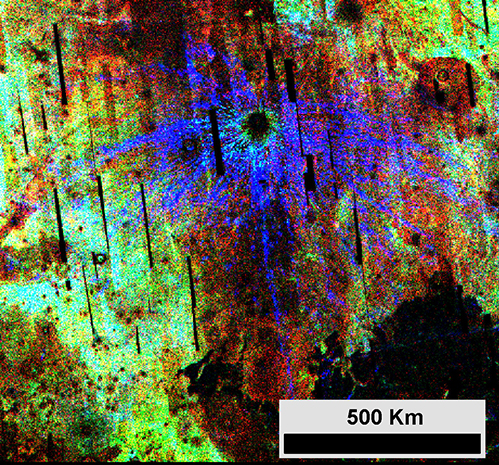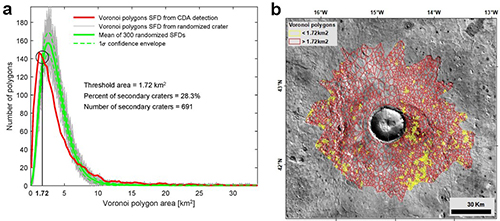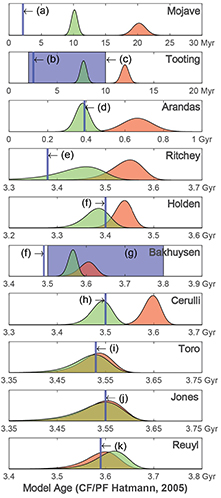Automatic Crater Counting: Model Ages Derivation of Large Martian Impact Craters.
- 1Space Science and Technology Centre, School of Earth and Planetary Sciences, Curtin University, Perth, WA, Australia (anthony.lagain@curtin.edu.au)
- 2CSIRO - Pawsey Supercomputing Centre, Kensington WA, Australia
Introduction: The knowledge of impact craters age constellating planetary surfaces is a crucial information involved in the understanding of the geological history of planetary bodies and more specifically on erosion rates measurements, meteorites ejection, impact flux evolution and the loss of magnetic field. The derivation of their age is currently performed through manual crater counting but this method is limited to small and/or young surfaces and in the case of the derivation of crater emplacement age, to a small set of impact craters. Here we used a Crater Detection Algorithm developed by [1] to solve this issue.
Automatic crater detection: We used the HiRISE mosaic [2] covering a part of the Jezero crater where 1624 craters have been manually identified. Our model has then been applied over the CTX global mosaic [2] covering the ejecta blanket of 10 large impact craters whom the emplacement age has been estimated in other studies. Our CDA detected 129,799 small impact craters larger than 70m in diameter superposed on their blanket. A visual inspection of the CDA results reveal the presence of a non-negligible portion of secondary craters (fig.1). Mainly circular, these secondary craters are identifiable due to their clustered spatial distribution. In order to automatically reproduce manual counting avoiding clusters of secondaries, we developed an Algorithm for the Identification of Secondary Crater (ASCI) inspired from already published technique [3, 4, 5] based on cluster analysis technique.

Figure 1: Mars crater detection map (RGB based on size). The blue rays correspond to 800,000 small impact craters (25m - 50m in diameter).
Secondary craters identification: A Voronoi polygons (VPs) tessellation is computed over a crater population detected on a counting area where the cratering density should be homogeneous.
The size-frequency distribution (SFD) of VPs is then calculated and compared to those produced by 300 different impact crater population containing the same number of craters than the data, whom the position is randomly generated. The mean and the standard deviation of these VPs SFD are calculated (fig.2.a).
The intersection between the VPs SFD from the detected crater and those from the simulated population at +1σ correspond to the threshold value polygon size from which all detected craters located inside a VP whom the size is below this threshold are considered being clustered [5] and therefore from a secondary origin (fig.2.b). All of these detection are removed from the crater population used to date as well as their associated VP. The crater count area is finally recalculated taking into account the removing VPs.

Figure 2: ASCI process and results. a: simulation of 300 random VPs on the Arandas ejecta blanket. b: Distinction between VPs associated to crater clusters, considered here as secondaries and those outside of clusters according to the threshold area determined by ASCI.
Model age results: Red curves on figure 3 correspond to the Poisson probability density function (PDF) of the age derived from Craterstats II [6] without the using of the ASCI while green curves are the PDF of ages using the ASCI. Blue bars correspond to the model age reported in the literature, converted into the Hartmann (2005) CS [7] if necessary. The relatively slight difference observed between the ages derived in this study and those using manual count suggest that the technique is valid for this set of Martian craters. The results are even closer from the reported age using the ASCI. The inclusion of primary craters into crater clusters identified by the ASCI that have been then removed is one of the disadvantage of this technique. It is expected that a run of the ASCI considering an area where the crater clusters dominate the entire crater population, within a crater cluster, on a too small area or exhibiting a too low number of impact craters would lead undoubtedly to an obvious secondary craters identification bias. We therefore catch the reader attention on the fact that the technique presented here should not be blindly used and should always be accompanied by a careful inspection of the automatic detection crater population and the results of its filtering using the ASCI.

Figure 3: Model ages derived for each crater with and without using the ASCI, respectively the green and the red curves. Blue bars corresponds to the age reported in the literature. (a) Werner et al., 2014 ; (b) Mouginis-Mark et al., 2012 ; c) Hartmann et al., 2010 ; (d) Lagain et al., 2020 ; (e) Sun & Miliken, 2014 ; (f) Robbins et al., 2013 ; (g) Tornabene et al., 2012 ; (h) Berman et al., 2011 ; (i) Fairen et al., 2010 ; (j) Mangold et al., 2012 ; (k) Vijayan et al., 2020.
Conclusion: Used by following advices stated in the previous section, the automatic crater count using our CDA coupled to a cluster analysis aiming to remove potential secondary crater clusters contamination (ASCI) is a powerful tool allowing to generate consistent isochrones for surfaces of Mars even in a context of secondary crater contamination. The combination of both tools offer thus a way to access to the emplacement age of many impact craters. This can be used to investigate potential temporal fluctuation in the size frequency distribution of impact craters on the surface of Mars. Applied to other geological structures, this can also be used to the reconstruction of the geological history of a portion of the Martian surface at a regional scale. The ASCI will be released as a toolbox implementable to ArcMap (ESRI).
References: [1] Benedix, G. K. et al., 2020, ESS, 7, e2019EA001005. [2] Dickson, J. L. et al., 2018, 49th LPSC, Abstract #2480. [3] Michael, G. G. & Neukum, G., (2010), EPSL, 294, 223-229. [4] Salih, A. L. et al., 2017 Int. Arch. Photogramm. Remote Sens. Spatial Inf. Sci., XLII-3/W1, 125-132. [5] Andronov, L. et al., 2016, Nature, Sci. Reports, 6, 2045-2322. [6] Michael, G. G. et al., 2012, Icarus, 218, 169-17, [7] Hartmann, W. K. (2005) Icarus, 174, 294–320.
How to cite: Lagain, A., Servis, K., Norman, C., Benedix, G., and Bland, P.: Automatic Crater Counting: Model Ages Derivation of Large Martian Impact Craters., Europlanet Science Congress 2020, online, 21 September–9 Oct 2020, EPSC2020-477, https://doi.org/10.5194/epsc2020-477, 2020

